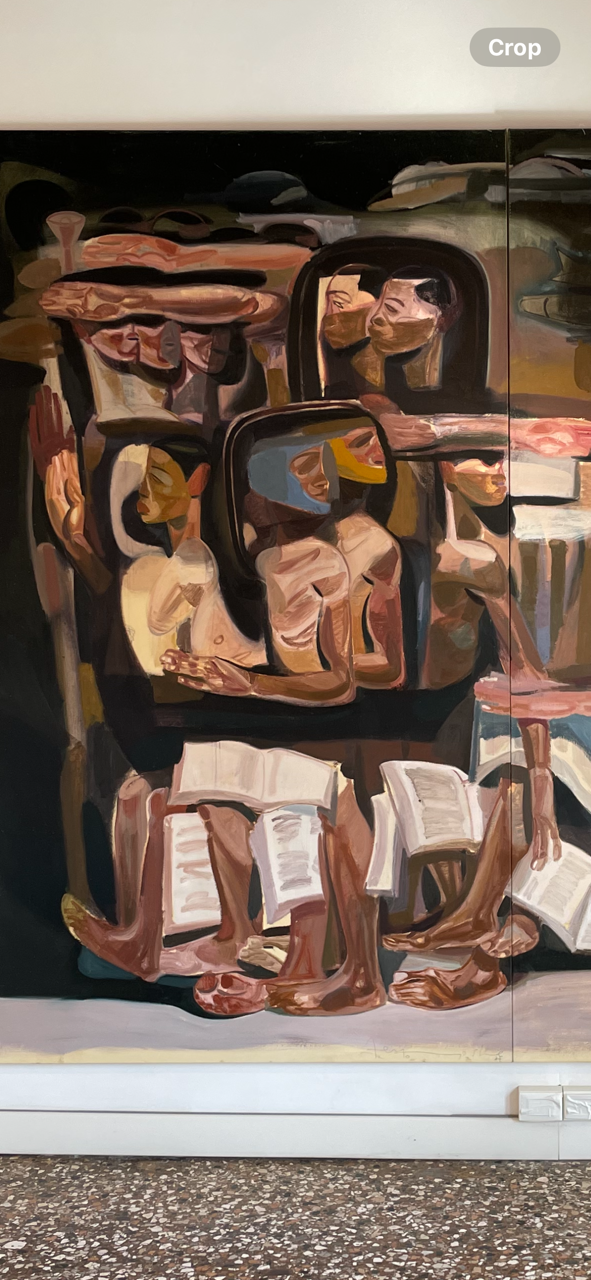Art & Poetry
Tesfaye Urgessa at the Ethiopian pavilion in Venice, 2024
“Painting is poetry that is seen rather than felt, and poetry is painting that is felt rather than seen.” – Leonardo da Vinci
Artists and poets lead different kinds of lives and leave different kinds of marks. One for the eye, one for the ear, but both dependant on the thrill of recognition. And still, art and poetry have long been intertwined, their connection forming a rich tapestry of human expression that transcends individual mediums. From Homer and Keat’s writings inspired by visual art to David Hockney’s paintings based on poems, across cultures, artists and poets have drawn inspiration from each other, exploring the depths of emotion, imagination, and symbolism through their respective crafts. Both art and poetry are concentrated mediums. Their engine is metaphor and the power of metaphor cannot be diminished, as seen at its earliest in the cave art and objects of the Mesolithic – for image contains metaphor as much as the word.
Artists may draw inspiration from poetry's themes, symbols, or imagery, infusing their creations with layers of meaning and complexity. Similarly, poets often find inspiration in visual art, using paintings, sculptures, or photographs as prompts for their own poetic explorations. At the heart of this connection lies the shared desire to evoke emotion and provoke thought. Just as a poem can paint vivid images in the mind's eye with carefully chosen words, art can capture the essence of a moment or idea through colour, form, and composition.
This exchange has however not carried on strongly into modern day. Ovid’s Metamorphoses and Dante’s Divine Comedy are two of the most enduring. JW Waterhouse’s The Lady of Shalott shows the ill-fated heroine of Tennyson’s famous verse moving inexorably towards her watery death “like some bold seer in a trance”. Another narrative illustration of a heroine on the point of meeting her watery fate is Millais’s Ophelia. The Victorian era was the last big hurrah of literature-inspired visual works of art, and it was decidedly gothic in flavour. But the 20th century saw the death of narrative painting, and illustrations from myth and literature dropped out of fashion. Painters were still influenced by literature, but now in more abstract, nebulous ways. Instead, we find a decisive switch, with writers turning increasingly to the works of painters and sculptors. Poets looked to the art historical canon for inspiration – however, less and less so as time went on.
A curatorial perspective
What has become more common place is using art and poetry in a curatorial context to enhange each other. According to the Poetry Foundation, “through the imaginative act of narrating and reflecting on the ‘action’ of a painting or sculpture, the poet may amplify and expand its meaning.” The term ekphrastic refers to poetry that is inspired by or describes a work of art. Ekphrastic poetry invites readers to engage with a visual artwork through the lens of language, with one art form illuminating the other and requiring the use of multiple senses. The combination can transform observers into participants and prompt them to notice things they might otherwise have missed.
This is not surprising: All art responds to or derives from other existing material. Artworks address one another, intentionally or not. In a complementary way, approaching art through writing poetry complicates our engagement with the artwork at the same time as it expands our understanding. Lyrical writing offers very open-ended structures, which need not come to conclusions. Combining systems of verbal and visual representation expands the possibilities of both language and art. An ekphrastic poem does not attempt to resolve or explain an artwork. Rather, it charts the artwork’s resonance as it moves through different levels of perception and creates conditions for new art to germinate (in this case, in poetic form). Conversely, the language that grows from the viewer’s interaction with the work needs to rise to the challenge of pinpointing the often ineffable encounter with art. By describing it through poetry, we work to listen to our thoughts and to activate underused language pathways in our minds.
But poetry, used in an ekphrastic sense is not mere description. It is relatively easy to describe but harder to create and to create something out of nothing. Poetry after all “makes nothing happen”, which - rather than a criticism - is a positive critique about the role of poetry; that is to say, poetry transforms nothingness into something very real, in the same way that words create worlds from nothing and visual arts form ideas, dreams and concepts into something to be seen and experienced by others.

